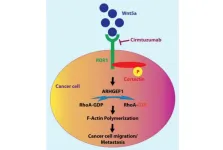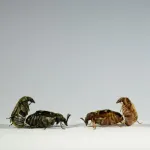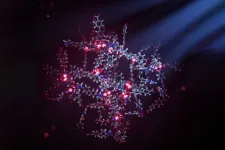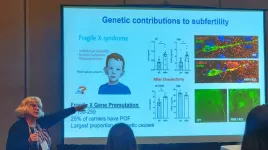(Press-News.org) Cambridge, Mass. - Researchers at the Forsyth Institute have discovered an important mechanism that may have profound implications for how we prevent colorectal cancer. Oddly enough, their discovery began in the mouth.
Colorectal cancer is the second most deadly cancer, killing over 52,000 people a year. Increasing evidence indicates Fusobacterium nucleatum, an opportunistic oral pathogen is one of the factors causing colorectal cancer. Fusobacteria are often found in healthy mouths, living in balance with other bacteria in the oral microbiome. It is considered opportunistic because in certain conditions it quickly grows out of control and causes damage to the human host.
The researchers wanted to understand what kept Fusobacteria in check in healthy mouths. They found that a molecule naturally produced by the human host directly targets Fusobacteria and keeps it from taking over. The molecule is a small RNA.
Their results, described in “Targeting Fusobacterium nucleatum through Chemical Modifications of Host-derived Transfer RNA Fragments,” which was published in the ISME Multidisciplinary Journal of Microbial Ecology, suggest a chemically modified version of this molecule could be used as a potential therapeutic to prevent colorectal cancer in the future.
“The amazing thing about this small RNA,” said Dr. Xuesong He, a Forsyth Senior Member of Staff who led the study, “is that it is very potent and very targeted. It doesn’t kill all the bacteria, good and bad. It only inhibits Fusobacteria. The ability to target a specific pathogen is what makes the molecule a promising therapeutic agent.”
The oral microbiome, which is made up of communities of microbes, plays an important role in human health and disease. Disease occurs when the balance between the bacteria and host is upset. Certain pathogenic bacteria might start to increase and cause problems.
How does a microbe in the mouth affect other parts of our body? “In a healthy mouth with good hygiene,” explained Dr. Pu-Ting Dong, a Forsyth postdoctoral fellow and the co-first author of this study, “fusobacteria are kept in check. When the homeostasis of the mouth is disrupted by bad oral hygiene or weakened host immunity, it can create the perfect conditions for Fusobacteria to grow out of control.”
Often this overgrowth of Fusobacteria causes periodontal disease. However, it can also lead to more fatal diseases, such as colorectal cancer. If someone brushes and flosses irregularly and gets microbleeds, the bacteria can enter and travel through the bloodstream to other parts of the body, such as the colon. In addition to colorectal cancers, imbalances in the mouth are directly linked to other systemic conditions such as diabetes and Alzheimer's.
As part of the study, Dr. He’s group teamed up with Dr. Jiahe Li (the co-corresponding author of this article) from Northeastern University and chemically modified the small RNA to be even more effective at inhibiting and preventing fusobacterial overgrowth. An international patent (PCT/US21/19890) has been filed for these modified Fusobacterium-targeting small RNAs by the Forsyth Institute and Northeastern University.
The researchers hope that their continued work in this field will lead to effective preventative therapeutics for Fusobacteria-related systemic diseases.
Other collaborators on the study included Drs. Wenyuan Shi and Lujia Cen from the Forsyth Institute; Dr. Mengdi Yang from Northeastern University.
The work was supported in part by The National Institute of Dental and Craniofacial Research of the National Institutes of Health (NIH) under Awards R01DE030943 and Forsyth Institute Collaborative Pilot grant FSI_CP05
###
About The Forsyth Institute
The Forsyth Institute, founded in 1910, is the world’s leading independent research institution focused on oral health and its connection to overall wellness. Forsyth was founded as a pediatric dental hospital serving disadvantaged children in the Boston area. Today, the Institute is grounded in a 3-pillared strategic plan focused on biological research, clinical service and public health outreach, and technological innovation. Forsyth conducts its original mission through a mobile public health dental program called ForsythKids.
END
Each year about 1.5 million people in the U.S. survive a traumatic brain injury due to a fall, car accident, or a sports injury, which can cause immediate and long-term disability.
University of Maryland School of Medicine (UMSOM) researchers wanted to better understand what happens in the brain during injury, so they conducted a study in mice to determine how different types of brain cells in mice react to severe trauma. In a new study published in the January issue of Autophagy, they found that after traumatic brain injury, the brain’s immune system cells’ internal recycling ...
Animals, like humans, appear to be troubled by a Linda problem.
The famous “Linda problem” was designed by psychologists to illustrate how people fall prey to what is known as the conjunction fallacy: the incorrect reasoning that if two events sometimes occur in conjunction, they are more likely to occur together than either event is to occur alone.
Now, for the first time, UCLA psychology researchers have shown that this type of logical error isn’t the sole province of humans ...
“Cortactin (also known as EMS1 or CTTN) is expressed broadly in a variety of cancers [...]”
BUFFALO, NY- April 4, 2023 – A new editorial paper was published in Oncotarget's Volume 14 on March 21, 2023, entitled, “Impact of cortactin in cancer progression on Wnt5a/ROR1 signaling pathway.”
In this editorial, researchers Kamrul Hasan and Thomas J. Kipps from the University of California discuss cortactin—an intracellular cytoskeletal protein that can undergo tyrosine phosphorylation upon external stimulation and promote polymerization and the assembly of the actin filament that is required for cell migration. Upon stimulation, cortactin ...
Male beetles face a trade-off between competing with other males for mating opportunities and repairing damage to their sperm DNA, according to a study publishing April 4th in the open access journal PLOS Biology by Mareike Koppik from Uppsala University, Sweden, and colleagues.
Mutations in sperm and egg DNA can reduce the survival and fitness of offspring, so animals use a variety of repair and maintenance mechanisms in their reproductive cells. However, previous research has shown that sperm DNA has more mutations than egg DNA in a variety of ...
The prevalence of multimorbidity, the co-occurrence of two or more chronic conditions, varies depending on exactly how it is defined. And the healthcare costs associated with many disease combinations cost more together than the sum of each individual disease. Those are the conclusions of two new studies, publishing April 4th in the open access journal PLOS Medicine, that broadly analyze the concept and costs of multimorbidity.
Multimorbidity is increasing in prevalence due to improved survival from chronic diseases and population aging, and now poses major challenges to healthcare systems worldwide. ...
SCI Canada Awards 2023 dinner, seminar and presentations to take place on 18 April in Toronto
Seminar theme is ‘Unlocking the potential of science talent enabling impact on Canada’s economic growth’
Award winners include the first indigenous community members
Dr Paul Smith, Perimeter Institute for Theoretical Physics, will receive the 2023 Canada Medal
A panel representing the best of Canadian science and industry will discuss its role in boosting economic growth at a special awards event on 18 April in Toronto.
Winners of the 2023 SCI Canada Awards include ...
CAMBRIDGE, MA -- Materials known as metal-organic frameworks (MOFs) have a rigid, cage-like structure that lends itself to a variety of applications, from gas storage to drug delivery. By changing the building blocks that go into the materials, or the way they are arranged, researchers can design MOFs suited to different uses.
However, not all possible MOF structures are stable enough to be deployed for applications such as catalyzing reactions or storing gases. To help researchers figure out which MOF structures might work best for a given application, MIT researchers have developed a computational approach that allows ...
Sexual selection provides an answer to the existence of lavishly ornate signals in animals, but not to the question of why such signals are attractive, why do females prefer the extravagant plumage of peacocks? As part of an international team, researchers at Eötvös Loránd University (ELTE) have shown that the reason is not the presumed wasteful cost of ornaments, as honest signals need not have to be costly at all as long as cheaters would have to pay to fake them. Researchers have developed a general formula to calculate honest equilibrium in any model, independent of the cost ...
RIVERSIDE, Calif. -- A University of California, Riverside, study has identified the biological underpinnings of a reproductive disorder caused by the mutation of a gene. This gene mutation also causes Fragile X Syndrome, a leading genetic cause of intellectual impairment and autism.
The researchers found mutations of the Fragile X messenger ribonucleoprotein 1 gene, or FMR1, contribute to premature ovarian failure, or POF, due to changes in neurons that regulate reproduction in the brain and ovaries. The mutation has been associated with early infertility, due ...
PHILADELPHIA — Chronic kidney disease (CKD) is a strong cardiovascular risk factor and is often accompanied by hypertension and diabetes. Despite the disease’s prevalence—10 percent of individuals across the globe suffer from CKD—there are limited tools for measuring cardiac risk for CKD patients, until now. A new proteomic risk model for cardiovascular disease was found to be more accurate than current methods of measuring cardiac risk, according to a new study led by researchers in the Perelman School of Medicine at the University of Pennsylvania. The study published today in the European Heart Journal.
The Penn researchers developed ...






